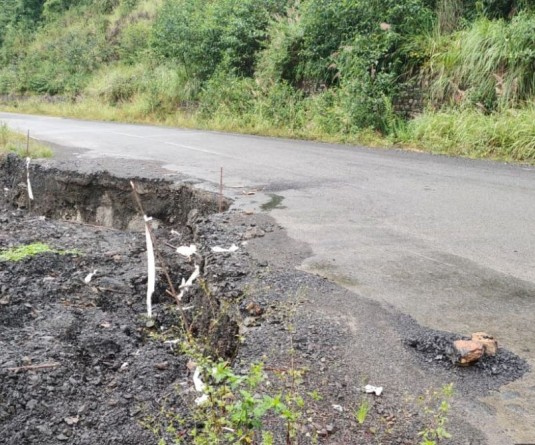A stone pulling ceremony to commemorate 142 years of the Anglo-Naga peace treaty was held at Mezoma village on December 6. (Morung Photo)
.jpg)
Morung Express News
Kohima | December 6
Marking 142 years of ‘Vitho’ (Peace treaty), an agreement for peace and cessation of hostilities between the British and the Nagas on March 27, 1880, a traditional stone pulling ceremony was held at Mezoma village, 20 KM away from the state capital on December 6 as part of the Hornbill Festival.
The scenic village of Mezoma echoed with howling and chanting as hundreds of men, women and children both young and old, geared in traditional attires awaiting the stone pulling to take off.
Pronouncing the traditional blessing before the stone pulling, Rovigwelhou Chüsi, GB said “Although a peace treaty was signed between the Nagas and Britishers long time ago in traditional custom, there was no symbol to signify the peace treaty. Hence, we are pulling this stone to mark the peace treaty between the Nagas and the Britishers.”
With this stone, he prayed “may the Nagas and British live in peace and unity as long as we live on this earth. Let God’s blessing be upon each and everyone who have come to this ceremony, and let no one be injured or harmed in the process of pulling the stone.”
Friendship villages of Mezoma from Tuophema Village, Tesophenyu Village and Kikrüma village were invited to be part of the stone pulling.
History of the Peace Treaty
Highlighting the history behind the Peace Treaty, Neivikuolie Khatsü said that it was in the year 1832; the British came across Naga territory who tried to invade and carry out many expeditions.
In the process, the Battle of Khonoma took place in the year 1879, where Damant was killed, which led the Britishers to call for reinforcement from different quarters, pushing the Nagas to different corners of the jungle.
However, he said the Nagas had never surrendered to it. Yet, seeing the difficulties, Nagas agreed to enter into a ‘Vitho,’ an agreement for peace and cessation of hostilities, at Mezoma village.
As per oral testimonies about the solemn ceremony, Khatsü narrated “on March 27, 1880, two men from Mezoma and Khonoma held the head of the cat while the British representative held the lower end of the cat slicing it into two from the neck.’
Following the treaty, he said Angami Nagas, on their part have never created nor initiated any hostility towards the British till their departure in 1947. “We have kept our promise thus far” he added.
Nagas must make peace within
Gracing the ceremony as the chief guest, Nagaland Chief Minister, Neiphiu Rio appreciated Mezoma for their effort in preserving their history to posterity.
With the stone pulling marking ‘an agreement for peace and cessation of hostilities’, Rio emphasised on the need for peace and unity within the Naga families irrespective of tribes.
Remarking an adage, he maintained that if there is an enemy within the family, that family can never stand. Hence, he said, “Nagas as brothers and sisters should make peace within ourselves and work in unity.”
As Christians, he maintained that Nagas should forgive each other, make peace and take society forward.
The Chief Minister also stressed on the importance of preserving and promoting the rich cultural heritage and traditions of the Nagas, which should be passed down to the younger generations.
The stone pulling ceremony attracted lots of tourists where the Mezoma villagers displayed their biggest and heaviest traditional head gears. During the programme, a booklet on the Anglo-Naga Vitho authored by Neivikuolie Khatsü and Thejalhoukho Casavi was released and distributed free of cost to all.





